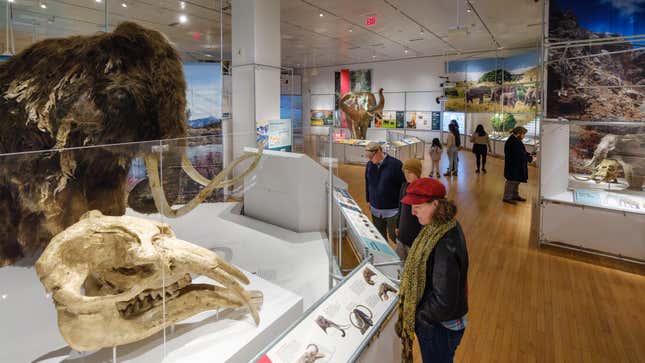The largest land mammal of our time has an evolutionary story at least 60 million years in the making. On Monday, a new exhibit revealing the ‘secret lives’ of the trunked giants will open at New York’s American Museum of Natural History, clueing us into how elephants evolved, communicate, and persevere in a world increasingly dominated by humankind.
The new exhibit is entitled ‘The Secret World of Elephants’ and it walks you through elephants’ journey to become the intelligent and, yes, massive creatures that they are. I visited the exhibit earlier this week and, while I wish it included more reconstructions of ancient proboscidean species, I think it does a terrific job of looking beyond elephants’ superlative size and more obvious traits to showcase how remarkable the animals really are.
Advertisement
Only three elephant species walk the Earth today. But over 200 species of proboscideans have called Earth home, and they lived on five of the seven continents (you missed out, Antarctica and Australia). The animals have an outsize (or perhaps proportionately sized) impact on human culture; they are political and religious symbols, and one of the most awesome examples of megafauna that still exists.
Advertisement
The exhibit is separated into five sections, dedicated to elephant evolution, physiology, intelligence and behavior, their habitats, and their relationships with humankind, including how elephants appear in human culture. There are interactive and touchable features (anyone want to grab dodgeball-sized models of elephant poop?) to play around with, as well as animated maps and high-definition videos showcasing the animals’ behaviors in the wild and in captivity. A personal favorite of mine is an interactive feature where you scan rings around a mammoth’s tusk to see how isotopes reveal where the animal lived at different points in its life cycle thousands of years ago.
Advertisement
Unfortunately, there’s only so much actual room for full-scale proboscideans in the room. The exhibit features four, by my count: a shedding woolly mammoth, an African savanna elephant (on whose side light shines, to showcase aspects of the animal’s physiology), and two Sicilian dwarf elephants, an extinct species that likely shrunk down as a result of the Island effect. Adults of the species were about the size of a Smart car. In my selfish opinion, this is what people come to museums for: to see animals that we cannot see at the zoo or even in photos and videos.

Advertisement
“It’s challenging to bring the elephant into the room, as it were,” said Lauri Halderman, a senior vice president for exhibition at the museum. “Somebody had to say it.”
“To be able to make a life-sized African elephant or a life-sized wooly mammoth, that’s something that we know how to do and I think we do pretty well,” Halderman added. “I think what’s more challenging is to show you behavior, to show you intelligence, to show you emotions—to give you a sense of really connecting with elephants.”
Advertisement
Perhaps the place where the exhibit most shines in this regard is a short documentary about the Samburu community of northern Kenya, who manage an elephant sanctuary called Reteti. The sanctuary takes in orphaned and abandoned elephant calves and returns them to the wild. The documentary spotlights the arrival and growth of a 15-month-old female calf named Shaba, and the ways Shaba develops into the first matriarch of Reteti, but also a leader in the eyes of the humans who raised her.
Human relationships with proboscideans—elephants, yes, but also mammoths and mastodons—extend back tens of thousands of years. The exhibit features coins from the times of Julius Caesar and Hannibal incised with images of elephants, which famously accompanied the latter on his advance across the Alps.
Advertisement
But even without humans around, elephants use tools, solve puzzles, and have a diverse way of communicating with other members of their species, including using the force of their footfalls. There’s something for everyone in this exhibit, and it’ll give you a new perspective on an iconic group of creatures. All extant elephant species are endangered, and the African forest elephant is critically endangered according to the IUCN Red List. MacPhee said that the urgent need for elephant conservation is a driving factor for the exhibit.
“Apart from just the appreciation of elephants and how they work, it’s the idea that their tenure on the planet is now contingent on what we do, just like it is for every other living thing,” he said.
Advertisement
The exhibition is temporary and opens to the public on November 13. Members can preview the exhibition starting today. And while you’re at the museum, swing by the much-needed overhaul of their permanent gems and minerals collection.
More: Elephants Might Be Self-Domesticated, Scientists Argue
Services Marketplace – Listings, Bookings & Reviews